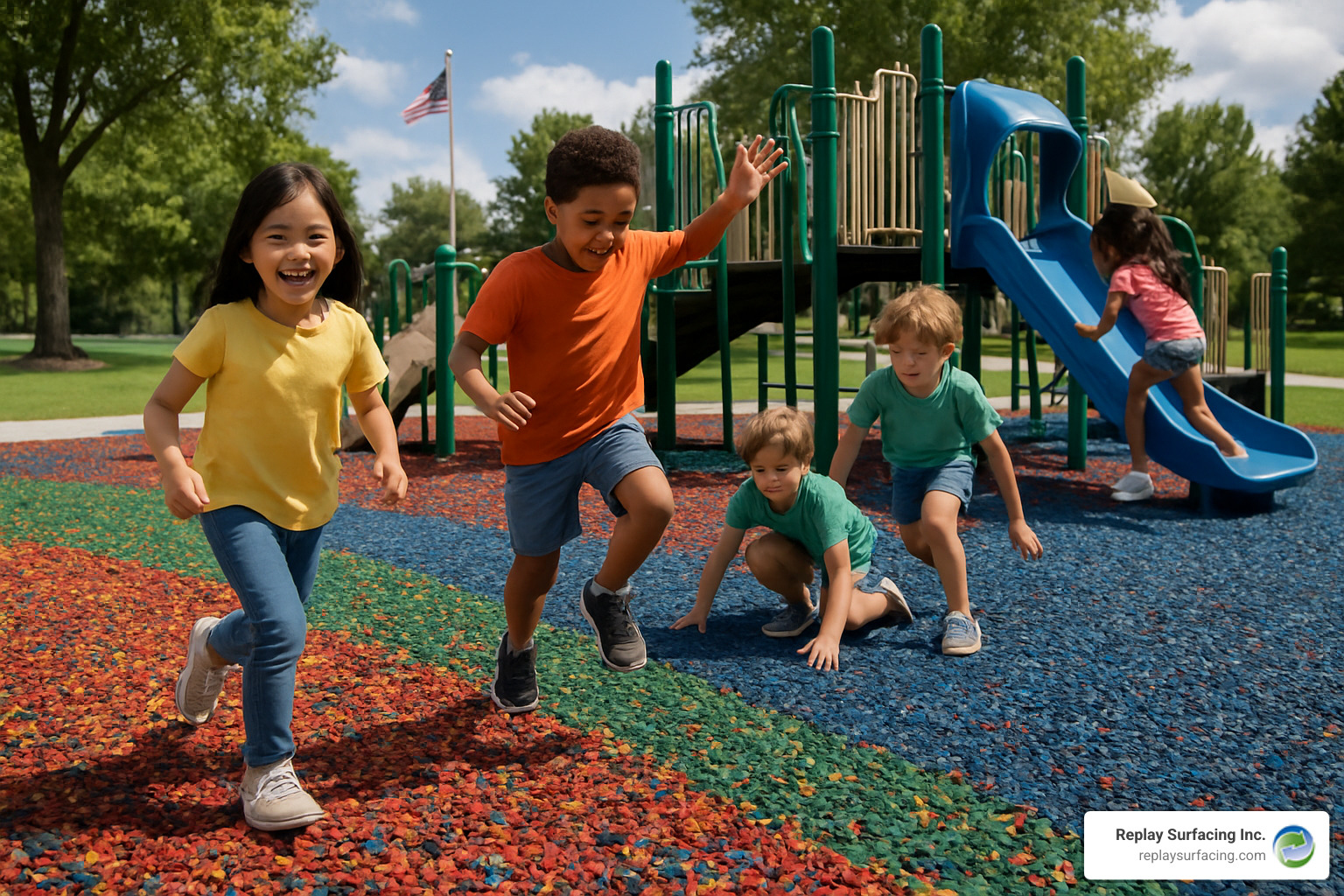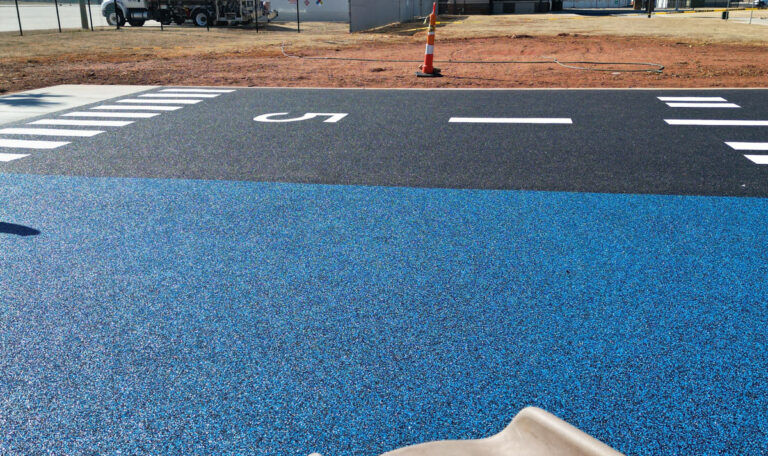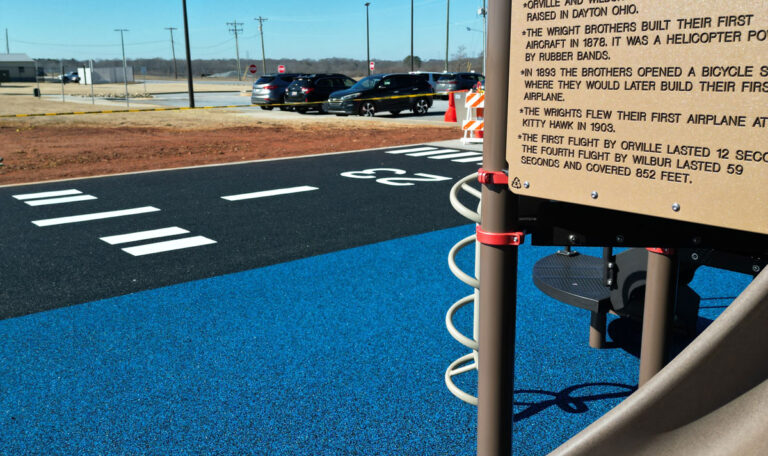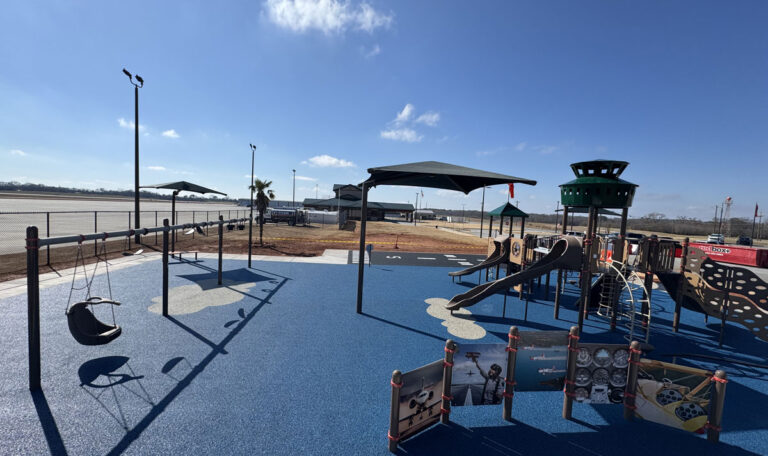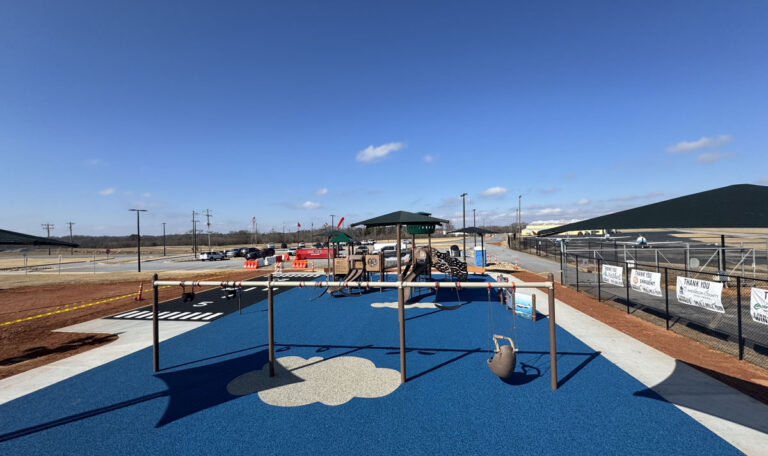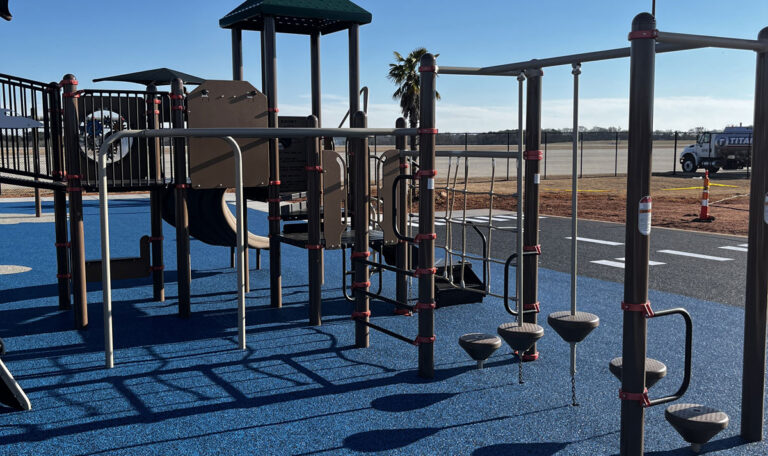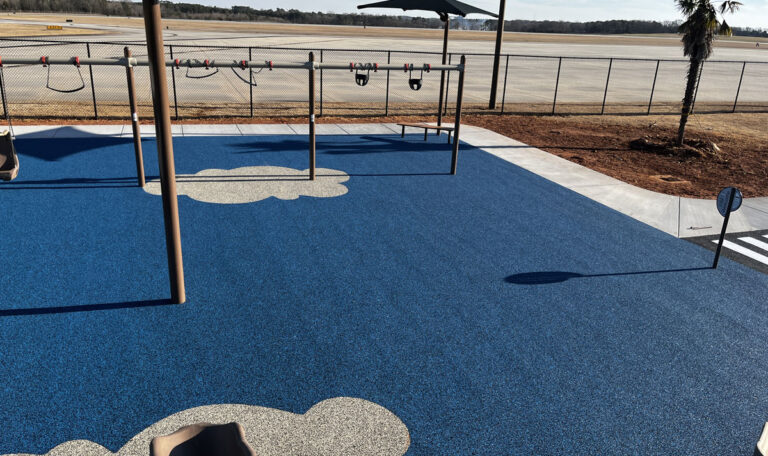Safety First: Understanding Non-Toxic Rubber Mulch Options
Non toxic rubber mulch is a specialized playground surfacing material designed to provide superior fall protection while minimizing exposure to harmful chemicals. For facility managers concerned about playground safety and environmental impact, here’s what you need to know:
What Makes Rubber Mulch Non-Toxic:
– Made from virgin rubber (not recycled tires) or thoroughly cleaned recycled materials
– Free from harmful chemicals like phthalates and “red list” substances
– Third-party tested for safety and indoor air quality
– Manufactured without steel wire contaminants (99.9% wire-free)
– Contains UV-stabilized, non-leaching colorants
With over 200,000 playground injuries occurring annually in the United States, selecting the right surfacing material is critical for child safety. Traditional playground surfaces like wood chips, sand, or asphalt simply don’t provide the same level of protection as properly installed rubber mulch. When installed at appropriate depths (3″ for residential, 6″ for commercial applications), quality rubber mulch can protect against falls from up to 20 feet.
Unlike recycled tire mulch, which was originally designed for roadways, true non-toxic options are specifically engineered for children’s play surfaces. These premium products typically use either virgin rubber or thoroughly processed recycled materials that eliminate potential contaminants.
As an engineer with expertise in sustainable materials and safety surfacing, I’m Landon Olson from Replay Surfacing, where we’ve transformed millions of pounds of scrap tires into safe, non toxic rubber mulch products that meet the highest safety standards while contributing to environmental sustainability.

Simple non toxic rubber mulch glossary:
– epdm rubber playground
– loose fill playground surfacing
– wetpour rubber surfacing
Virgin Rubber Nuggets – Soft Yet Sturdy
When you’re looking for the best non toxic rubber mulch for your playground, virgin rubber nuggets stand out as the premium choice. These aren’t repurposed materials – they’re specially crafted from closed-cell sponge rubber designed with children’s safety in mind from the very beginning.

What makes these nuggets special is their pure composition. Made from 100% new rubber that’s never touched a roadway or been exposed to environmental contaminants, these nuggets have a springy, cushioned feel that kids love and parents appreciate. The closed-cell structure gives them the perfect balance – soft enough to cushion falls but sturdy enough to maintain their shape year after year.
“Parents and school administrators keep telling us they want virgin rubber options for complete peace of mind,” shares our lead product developer at Replay Surfacing. “When your children are playing with this material every day, knowing it’s free from potential contaminants makes all the difference.”
Unlike surface-coated products, these nuggets feature color-fusion technology that runs throughout the entire material. This means those bright, playful colors stay true even after years of sunshine, rain, and thousands of little feet running across them. That’s why most premium virgin rubber products come with an impressive 20-year warranty – they’re built to last.
Another bonus? Virgin rubber nuggets stay heat-neutral. If you’ve ever walked barefoot on black recycled rubber on a hot summer day, you’ll appreciate this feature. These nuggets maintain a comfortable temperature even in direct sunlight, making them perfect for playgrounds in warmer regions like our Arizona and Southern installations.
Why This Non Toxic Rubber Mulch Stands Out
The safety profile of virgin rubber nuggets truly sets them apart. Each batch undergoes thorough third-party testing for VOCs (volatile organic compounds) and other potentially harmful substances. The premium options we offer are certified low-VOC and meet California’s tough Proposition 65 safety requirements – some of the strictest standards in the country for limiting substances that might cause cancer or reproductive harm.
When it comes to fall protection, these nuggets excel in ASTM F1292 impact testing. At just 3 inches deep, quality virgin rubber mulch can protect children from falls up to 12 feet high. Increase that to a 6-inch installation, and you’re covered for falls from as high as 20 feet. That’s significantly better protection than traditional wood chips or sand could ever provide.
We recently heard from a North Carolina school district after they installed our virgin rubber nuggets: “The safety difference is immediately obvious. There’s just the right amount of give when children fall, and parents love knowing the material is completely free from recycled tire contaminants.”
For daycares, preschools, and elementary schools where our youngest kids spend their days, virgin rubber nuggets offer both superior safety now and remarkable value over time. With basic maintenance, these surfaces remain effective and attractive for 20+ years – long after wood mulch would have decomposed or compacted into a hard, unsafe surface.
Premium Recycled Tire Mulch – Eco Value Pick
Looking for that sweet spot between budget-friendly and eco-conscious? Our premium recycled tire mulch hits the mark perfectly. At Replay Surfacing, we’ve mastered the art of changing used tires into non toxic rubber mulch that’s 99.9% wire-free and carefully cleaned of potential contaminants.

The environmental impact of our approach makes us smile every day. Did you know nearly 290 million scrap tires pile up in the United States each year? By rescuing these tires from landfill doom and giving them new life as playground surfacing, we’re tackling a major waste challenge while creating something genuinely valuable for communities.
“I used to see tire piles as eyesores,” says Maria, one of our long-time customers in Arizona. “Now when I watch kids playing safely on our recycled rubber playground, I see those same tires as something beautiful.”
Our premium recycled tire mulch goes through quite the change journey. First, we give those road-weary tires a thorough bath to remove grime and debris. Next comes the delicate operation of extracting all steel bands and wires before shredding the rubber into perfectly sized pieces. The final touch? A coating of fade-resistant, non-toxic sealant that locks in color and prevents any unwanted leaching.
One often overlooked benefit of our recycled rubber mulch is its impressive moisture retention. In our tests, it conserves up to 30% more water than traditional landscaping materials—a huge plus for our customers in drought-prone regions like Arizona and parts of North Carolina.
Color-wise, you’re covered for the long haul with our 12-year color warranty. Whether you prefer natural earth tones like brown and black or want to make a splash with vibrant blues, greens, and reds, your playground will maintain its visual appeal for over a decade with minimal maintenance.
For a closer look at all our loose rubber mulch options, including specs and color choices, check out our Loose Rubber Mulch page.
Why This Non Toxic Rubber Mulch Stands Out
Let’s talk value. While virgin rubber nuggets represent the absolute Cadillac of non-toxic playground surfacing, our properly processed recycled rubber mulch delivers excellent performance that won’t break the bank.
Our recycled rubber mulch comes with the IPEMA (International Play Equipment Manufacturers Association) seal of approval, confirming it meets rigorous safety standards. This isn’t just any certification—it verifies our product meets ASTM F1292-04 specifications for impact attenuation, the technical way of saying “it helps prevent injuries when kids fall.”
Beyond safety, our non toxic rubber mulch ticks all the regulatory boxes. It meets Consumer Product Safety Commission (CPSC) guidelines and Americans with Disabilities Act (ADA) requirements for playground accessibility. The surface remains stable and navigable for wheelchairs and mobility devices while providing that crucial fall protection all playgrounds need.
“We needed something that would work for every child in our district,” shares Tom, a school facilities director in Columbia, SC. “The wheelchair accessibility was non-negotiable, but so was our budget. Your recycled rubber mulch has been the perfect solution—safe, inclusive, and it doesn’t need replacing every other year like wood chips did.”
The feedback we hear most often? Peace of mind. Parents and facility managers alike tell us they sleep better knowing their playgrounds aren’t just safer for falls, but also free from splinters, mold, and the constant maintenance that traditional materials demand. And there’s something special about telling kids they’re playing on a surface that’s helping our planet too.
Bonded Rubber Mulch Mats – Low-Scatter Solution
For playground areas that need to stay put and look great, bonded rubber mulch mats offer the best of both worlds – the natural woodsy look of loose mulch with the stay-in-place reliability of a permanent surface. Think of them as rubber nuggets that have made a commitment to stick together, bound with child-safe polyurethane to create one seamless protective surface.

Anyone who’s maintained a playground knows the frustration of constantly raking scattered mulch back under swings and slides. That’s where bonded mulch truly shines. In those high-traffic zones where kids are jumping, swinging, and sliding all day, loose materials inevitably get kicked away, creating uneven protection. Our bonded non toxic rubber mulch mats solve this problem by keeping every nugget exactly where it belongs.
“Parents often tell us they love how the playground looks just as good at the end of the day as it did in the morning,” shares our installation team leader. “With traditional loose mulch, by afternoon you’d see bare spots under swings and piles of material pushed to the edges. Bonded mulch stays perfectly in place no matter how many little feet run across it.”
Wheelchair accessibility is another major advantage. The smooth, connected surface creates pathways that meet ADA requirements, allowing children using mobility devices to steer the playground with confidence. The seamless installation eliminates those tricky transition points that can cause wheels to get stuck or create tripping hazards for children with different mobility needs.
For playgrounds built on hillsides or uneven ground – which we see quite often in places like the Carolinas – bonded rubber mulch offers remarkable stability. Even during those summer thunderstorms that can wash away traditional materials, these mats stand their ground. The rain simply passes through the porous surface while the mulch stays firmly in place.
Installation typically involves a thoughtfully engineered two-layer system: a shock-absorbing base layer made from recycled rubber granules that provides the critical fall protection, topped with a wear layer of colorful rubber nuggets permanently bonded together. We can customize this system to meet specific fall height requirements while matching your color scheme or design vision.
To explore our complete range of bonded rubber mulch options and see more installation examples, visit our Rubber Mulch Mats page.
Ideal Use Cases
Bonded rubber mulch really proves its worth in specific playground scenarios where loose materials struggle to perform:
High-traffic zones benefit tremendously from bonded mulch’s stability. Those busy areas beneath swings, at slide exits, and around spinning equipment maintain consistent protection day after day, season after season. A school principal in Charlotte told us: “We used to rake under our swings almost daily. Now with bonded mulch, our maintenance team can focus on other priorities.”
Erosion-prone areas stay secure with bonded mulch, even on slopes or in rainy regions. The connected surface prevents material migration, ensuring safety standards remain consistent regardless of weather or terrain challenges. This makes it particularly popular in hillside playgrounds throughout the Southeast.
Creative play spaces come alive with bonded mulch’s design possibilities. We’ve helped schools incorporate educational elements like number grids, alphabet paths, and geometric shapes directly into their playground surfacing. The children engage with these colorful patterns while teachers appreciate the learning opportunities that extend beyond the classroom.
“The rainbow pathway we created with bonded mulch has become the most popular feature on our playground,” shared a daycare director in Nashville. “Not only do the kids love following the colors, but we’ve noticed it naturally encourages inclusive play as children of all abilities can steer it together.”
Bonded mulch also works beautifully as a transition material between different playground zones, creating smooth, accessible paths that connect various play areas. This thoughtful approach ensures the entire playground remains welcoming and accessible to every child who visits.
Safety & Certification Checklist for Non Toxic Rubber Mulch
Shopping for non toxic rubber mulch can feel like navigating a maze of technical standards and certifications. Let’s break down what really matters for your playground project in simple terms.
Think of safety standards as your playground’s safety net. The most important ones come from ASTM International, and two in particular stand out:
ASTM F1292-13 is all about how well a surface cushions falls. Imagine dropping a melon from different heights—this test is similar, but uses specialized equipment to measure exactly how much impact protection your surfacing provides. This matters tremendously because it directly relates to preventing serious head injuries.
ASTM F1951 focuses on accessibility. Can a child in a wheelchair easily steer the surface? This standard ensures that your playground welcomes everyone, regardless of mobility challenges.

When browsing non toxic rubber mulch options, always look for the IPEMA seal. This third-party certification is like a safety stamp of approval, confirming that independent experts have tested the product against those crucial ASTM standards. Think of it as your peace-of-mind guarantee.
ADA compliance isn’t just a legal requirement for public playgrounds—it’s about creating spaces where all children can play together. The Americans with Disabilities Act requires surfaces to be firm, stable, and slip-resistant. Both bonded rubber mulch and properly installed loose-fill rubber mulch can meet these requirements, creating pathways that welcome everyone.
The Consumer Product Safety Commission (CPSC) offers practical guidelines that translate all these technical standards into real-world recommendations. They recognize that non toxic rubber mulch outperforms traditional materials like wood chips or sand when it comes to cushioning falls.
Here’s a simple comparison that shows why rubber mulch has become so popular:
| Material | 3″ Depth Critical Fall Height | 6″ Depth Critical Fall Height |
|---|---|---|
| Non-Toxic Rubber Mulch | 8-10 feet | 16-20 feet |
| Wood Chips | 7 feet | 10 feet |
| Sand | 4 feet | 5 feet |
| Pea Gravel | 5 feet | 6 feet |
When we talk about Head Injury Criteria (HIC), we’re getting to the heart of playground safety. This measurement predicts the likelihood of serious head injury from a fall. The lower the number, the better the protection. Quality non toxic rubber mulch consistently achieves impressive low HIC values, especially when installed at the recommended depth.
As our safety compliance officer often says, “These standards aren’t just boxes to check—they represent real children being protected from real injuries. We take that responsibility seriously at Replay Surfacing.”
Every product we develop undergoes rigorous testing before it ever reaches a playground. We’re not just meeting minimum standards; we’re creating surfaces parents and facility managers can truly trust.
For those who want to dive deeper into the technical aspects, you can explore the complete ASTM International Standard F1292-13 for detailed specifications on impact attenuation testing and requirements.
Installation & Maintenance Best Practices
Turning your playground into a safe haven starts with proper installation of non toxic rubber mulch. Think of it as building the foundation for years of worry-free play – a little care now means a lot less headache later.

Make a safe choice for your playground — read our simple guide to toxic vs. non-toxic rubber mulch here.
When preparing your site, start by giving it a clean slate. Clear away those pesky rocks, sticks, and weeds that might be lurking. Next, take time to level the ground – this isn’t just about aesthetics, it ensures proper drainage and prevents puddles that can reduce the mulch’s protective qualities.
“I always tell folks that skimping on site prep is like building a house on sand,” says Mike, our installation team lead. “The extra hour you spend getting the ground right will save you dozens of maintenance hours down the road.”
One absolute must-do is laying down quality weed-permeable fabric as your base layer. This unsung hero prevents weeds from popping up while still letting water drain through. Avoid the temptation to use plastic sheeting – it might seem like a good idea, but it traps moisture and creates a swampy mess that no playground needs.
Proper edging is another key to success. Whether you choose landscape timbers, rubber curbing, or another containment system, good borders keep your mulch where it belongs – under the feet of playing children, not scattered across your lawn.
Installation Depth
When it comes to non toxic rubber mulch, depth isn’t just a recommendation – it’s a safety requirement. For home playgrounds, aim for a minimum 3-inch layer, which protects falls from heights up to 8-10 feet. Commercial playgrounds need more cushion, with 6 inches recommended to handle falls from as high as 16-20 feet.
Fresh mulch will settle over time, especially in high-traffic areas. We typically suggest adding an extra 10% to your calculated amount to maintain proper protection after the initial settling period. This small buffer can make a big difference in maintaining safety standards.
A school principal in Charlotte told us recently, “We installed at 6 inches, and after a year of energetic kindergartners, we still measured over 5 inches everywhere. That extra bit we added on installation day was absolutely worth it.”
For help figuring out exactly how much mulch your space needs, check out our detailed guide on Installing Rubber Mulch. Our calculator takes the guesswork out of ordering the right amount.
Ongoing Maintenance
One of the joys of choosing non toxic rubber mulch is the minimal upkeep compared to traditional materials. No more annual replacement or weekly raking – but a little TLC still goes a long way.
Make it a habit to check your mulch depth annually, especially in high-traffic zones like under swings and at slide exits. A simple depth gauge (even a marked popsicle stick works!) helps identify areas that might need a top-up to maintain proper protection.
While rubber mulch stays put better than wood chips, giving it an occasional rake helps maintain an even protective surface. Use a plastic rake with rounded tines rather than sharp metal ones that might damage the rubber pieces.
Seasonal cleanup is straightforward too. A leaf blower on low setting whisks away fallen leaves and debris without disturbing the mulch beneath. After heavy rains, take a quick walk through the playground to check for any spots where water might be pooling – these could signal compaction issues that need addressing.
“We switched from wood chips to rubber mulch at our daycare five years ago,” shares a facility manager from Raleigh. “The difference in maintenance time is night and day. What used to be a monthly chore is now just a quick seasonal check.”
Cost-Saving Tips
Smart planning can maximize your investment in non toxic rubber mulch without cutting corners on safety. For larger playgrounds, bulk supersacks (typically 2,000 pounds) offer significant savings compared to individual bags. They’re perfect for commercial installations or bigger residential projects.
Using an accurate coverage calculator prevents the twin headaches of running short mid-installation or wasting money on excess material. Our online calculator factors in your specific dimensions and desired depth to give you a precise estimate.
Don’t overlook what you already have! If your playground has suitable existing borders, reusing them can trim your budget considerably. And for larger projects where budget is tight, consider a phased installation approach – start with high-risk areas under climbing equipment and swings, then expand as funds allow.
A parks director in Indiana shared, “We initially balked at the upfront cost, but after calculating what we’d spent annually replacing wood mulch, we realized rubber mulch would pay for itself in under four years. We’re now in year five and the surface still looks great.”
With proper installation and minimal maintenance, your non toxic rubber mulch playground will provide a safe, accessible play surface for many years to come – and that’s the kind of investment that truly pays off in both safety and peace of mind.
Cost, Lifespan & Environmental Impact
When it comes to playground surfacing investments, non toxic rubber mulch offers compelling long-term value that goes beyond the initial price tag. Let’s break down what facility managers and parents should know about the economics and environmental aspects of this durable playground solution.
Lifespan and Return on Investment
Quality rubber mulch isn’t just safer—it’s remarkably long-lasting. With a typical lifespan of 10-20 years and manufacturer warranties ranging from 12-20 years, this surfacing solution dramatically outperforms traditional materials. Wood chips, by comparison, need replacement every 1-2 years as they decompose, compact, and wash away.

A recent cost analysis for a Beaverton, Oregon school district revealed something interesting: while rubber mulch required about three times the initial investment compared to wood chips, the 15-year total cost was less than half thanks to eliminated annual replacements and reduced maintenance needs.
“Schools are often surprised when we show them the numbers,” shares our financial analyst. “The breakeven point typically arrives around year 3-4, after which the savings just keep growing. It’s like watching compound interest work in your favor.”
The economic benefits extend beyond just replacement costs. Water conservation is substantial—rubber mulch reduces irrigation needs by up to 30% by preserving ground moisture. For our playground clients in drought-prone Tucson, this water-saving aspect alone has been a deciding factor.
There’s also the pest resistance advantage. Unlike organic mulches that can become termite condominiums, rubber mulch won’t attract wood-destroying insects or require pest treatments. And don’t overlook the labor savings—maintenance teams spend significantly less time raking, replenishing, and managing rubber surfacing, freeing them up for other priorities around your facility.
Environmental Considerations
The environmental story of non toxic rubber mulch isn’t one-dimensional—it varies depending on which product you choose:
Virgin rubber products shine when it comes to purity. They’re manufactured from new materials with minimal risk of contaminants, though they do carry a higher manufacturing energy footprint. These products typically undergo rigorous third-party testing for VOCs and chemical emissions, making them ideal for facilities with strict environmental health policies.
Premium recycled products tell a different but equally compelling environmental story. Each ton of recycled rubber mulch diverts approximately 75-100 waste tires from landfills. That’s significant when you consider that tires can take over 100 years to decompose naturally. These products undergo specialized cleaning and processing to remove potential contaminants, with testing for heavy metals and leaching potential.
Fire safety is another crucial consideration, especially for playgrounds in fire-prone regions like parts of Arizona and California. Quality rubber mulch products undergo fire-safety testing according to 16 CFR 1500.44 standards and are classified as non-flammable—a significant safety advantage over wood products.
“We believe in complete transparency about environmental trade-offs,” our sustainability director often says. “While recycled products contribute wonderfully to waste reduction, virgin rubber options may offer advantages in chemical composition. Different facilities have different priorities, and we respect that.”
For clients concerned about potential leaching, we provide comprehensive laboratory reports on zinc content and VOC emissions. All Replay Surfacing products meet or exceed EPA guidelines for heavy metal content and leaching potential, giving you peace of mind about what’s under little feet.
For more detailed information about playground surfacing economics, visit our page on Understanding Rubber Playground Surfacing Costs.
Frequently Asked Questions about non toxic rubber mulch
What if a child swallows a rubber nugget?
This question comes up in nearly every parent meeting, and fortunately, we have reassuring answers. Laboratory testing by Maryland Environmental Services showed that rubber nuggets remain inert in stomach acid and pass through the digestive system without breaking down. While nobody wants their child snacking on playground materials, the nuggets are non-toxic and unlikely to cause anything beyond minor stomach discomfort if accidentally ingested. Of course, proper supervision remains important, especially for toddlers exploring the world mouth-first.
Does the color fade or rub off?
Quality non toxic rubber mulch is designed for color stability. Virgin rubber nuggets have color fused throughout the material during manufacturing—there’s simply no surface coating to rub off. Our premium recycled products use an advanced coating process that molecularly bonds color to the rubber particles.
A daycare center director in Lake Charles, Louisiana recently told us: “After three years under the brutal Louisiana sun, our blue and green rubber mulch playground still pops with color. Parents appreciate that their kids come home with colorful memories, not colorful clothes.”
How can I verify a product is truly non-toxic?
With growing awareness of chemical safety, this question is more important than ever. When evaluating non-toxic claims, look beyond the marketing and focus on specific evidence:
First, check for third-party testing results. Reputable manufacturers provide independent laboratory test data for heavy metals, VOCs, and other potential contaminants—not just vague reassurances.
Second, look for indoor air quality certification. Premium products that meet standards for indoor air quality demonstrate minimal chemical emissions, which matters for sensitive children.
Third, verify Proposition 65 compliance. Products meeting California’s stringent Prop 65 requirements have been verified free of chemicals known to cause cancer, birth defects, or reproductive harm at levels requiring warning labels.
Finally, insist on material source disclosure. Manufacturers should clearly state whether their product is made from virgin rubber or recycled tires, and if recycled, detail the processing steps taken to remove contaminants.
At Replay Surfacing, we believe in backing our non toxic rubber mulch with comprehensive documentation. We provide detailed test results and certification information because we understand that when it comes to children’s safety, transparency isn’t optional—it’s essential.
Conclusion
As we’ve explored throughout this guide, non toxic rubber mulch represents a significant advancement in playground safety surfacing, offering superior fall protection, exceptional durability, and reduced maintenance requirements compared to traditional materials. Whether you choose virgin rubber nuggets, premium recycled tire mulch, or bonded rubber mulch mats, these products provide decade-long cushioning that helps protect children from serious playground injuries.
The investment in quality rubber mulch delivers compelling long-term value. While the initial cost exceeds that of wood chips or sand, the extended lifespan (10-20 years versus 1-2 years for organic materials) and minimal maintenance requirements result in lower total ownership costs over time. Additionally, the superior fall protection capabilities of rubber mulch create safer play environments that may reduce the frequency and severity of playground injuries.
From an environmental perspective, rubber mulch contributes to greener play spaces through water conservation, elimination of chemical treatments, and—in the case of recycled products—diversion of waste tires from landfills. For organizations with sustainability goals, properly sourced rubber mulch can be an important component of environmentally responsible facility management.
At Replay Surfacing, we’re proud of our role in changing waste tires into safe, non-toxic playground surfaces that serve communities across the country. From our locations in Charlotte and Raleigh, NC to Tucson, AZ and beyond, we’re committed to providing products that meet the highest standards for safety, durability, and environmental responsibility.
For playground designers, school administrators, parks departments, and homeowners seeking to create optimal play environments, non toxic rubber mulch offers a compelling combination of safety, aesthetics, accessibility, and value. By choosing the right product for your specific needs and following proper installation and maintenance practices, you can create a playground surface that will provide safe, engaging play opportunities for years to come.
For more information about our complete range of playground surfacing options, visit our playgrounds information page.

